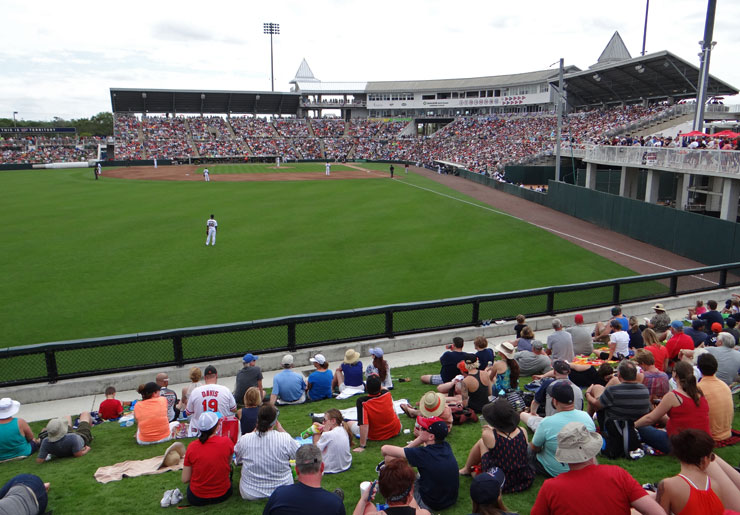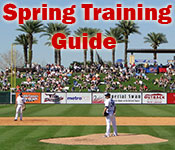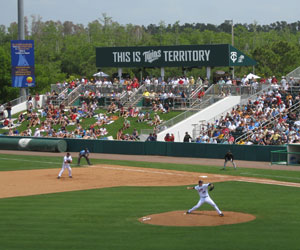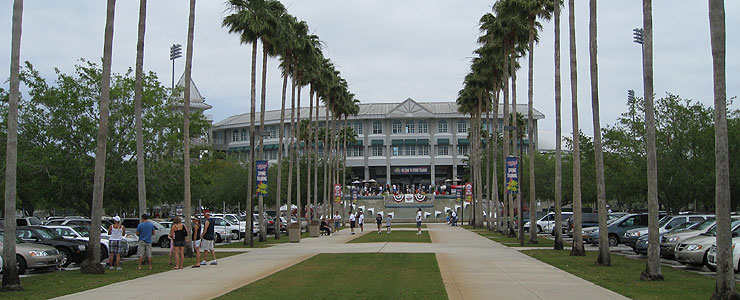
|
[ Hammond Stadium underwent a major renovation in 2014-15. The review here predates the stadium's changes. ]
Hammond Stadium is the Jekyll and Hyde of spring training ballparks. The centerpiece of the 80-acre Lee County Sports Complex, the stadium is well known for its appealing exterior and bland interior, which is even more disappointing given the grandeur of design found outside. The stadium's exterior was designed to evoke comparisons to Churchill Downs. The most notable example of that inspiration is the spire-topped staircase attached to the left edge of a façade that is both tall and beige. The walk towards that façade is a scenic one, as fans approach Hammond Stadium via palm tree lined paths that lead to an attractive waterfall fountain near the stadium's entrance, where water cascades down an outer wall into a retention pool reminiscent of a wishing well. With its distinct architecture and usage of tall royal palms and cascading water as focal points, the winter home of the Minnesota Twins has an exterior that can't be matched at any other ballpark in the Grapefruit League. But the impressive initial impression fades when inside, where the two story single-deck stadium lacks much in the way of creativity. Fans enter Hammond Stadium through entrance gates found on either side of the waterfall display, walking up stairs to get to the concourse level. The grandstand is divided into a lower section with dark green plastic folding seats and an upper section that contains aluminum benches. The aisle that separates the box seats from the bleachers is narrow, as are the portals that connect the interior aisle to the main concourse, which is behind the grandstand. As such, concession stands have no view of the playing field. Although the concourse is not very wide it is covered thanks to the stadium's press box and roof, which has its primary supports affixed to the concourse's wall. The roof is made of aluminum and angles sharply upward, rather than outward. That design doesn't provide much cover for fans, although it does cast shade upon all who sit in the top five rows of the reserved seats, which is what the bleachers are known as. In most stadiums bleachers are either absent or make up a minority of the seating, but about half of Hammond Stadium's capacity is comprised of them. The grandstand is symmetrical and almost completely contained within the infield, which is possible because more rows of seats (32) are found at Hammond Stadium from top to bottom than at a typical spring training ballpark. But adding more rows into a smaller space also means that the top rows of the upper grandstand are further away than at most stadiums of a similar size, although the extra distance is pretty insignificant.
To build the berm and party deck, the visiting team bullpen had to be relocated to the right field corner. The Twins’ bullpen begins where the third base grandstand ends. Fans standing along the outer concourse there can watch the Minnesota pitchers warm up and the home team has a decided advantage in doing so, as five mounds are in the Twins' ‘pen compared to just two for the visitors. The Twins have retired five numbers during their history in Minnesota and they are displayed on the façade of the press box, as are pennants listing the nine years the team had made the playoffs. Unlike many stadiums, the press box does not encroach upon the upper rows of seats behind home plate, but like most the structure contains some luxury suites, which are referred to as sky suites. Additional premium seating can be found between the dugouts in the aptly named Dugout Box seats, which are at field level. So too is the Bullpen Picnic Pavilion, which is next to the Twins bullpen but has no view of the playing field. The picnic tables on the third base concourse suffer the same fate, although the set found on the right field deck are obstructed by fans, opposed to the backside of the grandstand. This is a ballpark that takes their beer seriously. Plenty of proof is found in the Beer Garden. Tucked under the grandstand at the edge of the third base concourse, the Beer Garden is loaded with patio furniture, neon signs, two televisions and numerous beers, both in the bottle and on draft. Concessions on the concourse and party deck add to the wide selection of beer brands available within the stadium’s confines. Budweiser may claim to be the King of Beers, but Hammond Stadium is the undisputed King of Beer Choices among spring training ballparks. In 2009, an astounding 18 different beers could be found on tap. Beneath the concourse and directly under the Beer Garden are numerous batting cages that Twins players use before, during and sometimes after the game. Rather than have a concrete back wall the area the cages are in uses chain link fencing, which lets fans outside of the stadium peer into what are normally private workouts. Although player accessibility is limited inside of the stadium, intimate encounters are available outside of it. Besides the batting cage area, fans can also get close to Twins players as they walk between their main practice field and the stadium along a route where the barrier that separates fan from player is only a few feet high. Located directly across from the batting cages, the main practice field is literally in the shadows of Hammond Stadium and has a pair of covered bleachers set up behind its backstop. Behind the left-center field wall of the stadium a new and expanded scoreboard was erected in 2009 to replace an outdated version that stood on the same spot. Measuring 50’ wide by 24’ tall, the Daktronics designed scoreboard includes a 36’ wide LED message board at its bottom that lists what each hitter has done during the game and their last at-bat. Painted in team colors, the scoreboard is topped by ornamental truss work and a five foot diameter analog clock whose hands rotate around a Twins logo. The slogan “This Is Twins Territory” is written across the canopy that is on the party deck but the stadium’s sole gift shop features plenty of merchandise for fans of the other team that trains in Fort Myers, the Boston Red Sox, who play about seven miles away at City of Palms Park. The two teams share a friendly rivalry during the spring with the winner of the series of games played between them claiming the Mayor's Cup, which has been awarded by the City of Fort Myers since 1993, the year the Red Sox joined the Twins in Southwest Florida. Although outsiders would presume the Red Sox to be the region’s marquee draw, the Twins hold their own when it comes to total home attendance versus their Mayor’s Cup competition. Each fan that enters Hammond Stadium does so with a full color ticket that features a photo of a current Twin, as the ticket office eschews the typical Ticketmaster-style printouts most teams use for non-season ticket admission. But Hammond Stadium is anything but typical, so it’s no surprise that the tickets it sells are different. In a sense, the stadium transforms from a Dr. Jekyll to Mr. Hyde upon the usage of that ticket, at which time the beauty seen on the outside gives way to the blandness of the inside. And if it’s what’s on the inside that counts, then Mr. Hyde has won the contrasting battle of design that gives the stadium such a dual personality.
Location and ParkingHammond Stadium is one of five full sized baseball fields inside of the Lee County Sports Complex, which also contains two half baseball fields for use by the Twins and recreational facilities for use by local residents. The public's portion of the complex includes four softball fields, two soccer fields and an eight-acre lake for fishing. The complex is easily accessed from the four lane Six Mile Cypress Parkway, a north-south highway that is just 2½ miles from I-75. The pink tiled roofs ubiquitous across Florida top the office buildings that are just beyond the stadium's left field wall and, along with cars driving on the parkway, make up the playing field's backdrop. Parking is plentiful in the grass fields that extend from east to west outside of the stadium. The fields are intersected by gravel and paved lanes that are named after Twins greats, an example of which is Hrbek Rd.
Ballpark HistoryFort Myers has a long history with spring training. The Philadelphia A's were the first team to train in the city, starting in 1925, and the Indians, Pirates and Royals all set up camp afterwards, with each playing at Terry Park. But when Kansas City left the dilapidated Terry Park for the ambitious Baseball and Boardwalk Complex in 1988 they orphaned Fort Myers from the national pastime. At about the same time the Royals were leaving Lee County, of which Fort Myers is the county seat, the county started negotiating with the Minnesota Twins in hopes of replacing them. The Twins had trained in Orlando since their days as the Washington Senators and were seeking $5 million in improvements at Tinker Field to remain there. Orlando agreed to spend only $3 million on the improvements that the Twins were seeking. That gap gave Lee County an opportunity to get back into the springtime game, which the county's 5-member Board of Commissioners seized on March 22, 1989 by voting unanimously to build what would come to be known as the Lee County Sports Complex on 80 acres of land previously grazed by cattle in the southern part of Fort Myers. The Twins officially agreed to move their spring training headquarters to Fort Myers when they signed a 20-year lease on May 15, 1989. It would take $14 million and less than two years to build the Twins their new winter home. Lee County taxpayers footed the entire bill. The stadium was primarily the product of a pair of regionally run companies. Case Contracting of Plant City built it and architects from Tampa's Lescher and Mahoney were the lead designers, although they received some assistance from Ellerbe Becket, a well-regarded national firm that would later build Bank One Ballpark in Phoenix. Completed in February of 1991, the stadium hosted its first game on March 7, 1991, when the Twins trounced the local nine from Edison Community College 13-2 before 7,500 fans. The stadium name's was indistinguishable from that of the entire complex until March 19, 1994, when it was dedicated in honor of William H. Hammond, the county commissioner generally recognized as the man most responsible for getting the Lee County Sports Complex built. Though Hammond Stadium changed little over its first 15 years the Twins were happy enough with it that on August 3, 2004, they agreed to extend their lease with Lee County through the 2020 season. Sorely in need of some upgrades, Hammond Stadium finally got them in 2007 when it was enhanced with the addition of a berm, right field party deck and field level premium seats between the dugouts. Since then, the stadium's seats and lights were replaced (2008) and a new LED scoreboard was added (2009).

Hammond Stadium Facts, Figures & Footnotes
| |||||||||||||||||||||||||||||||||||||||||||||||||||||||||||||||||||||||||||||||||||||||||||||||||||||||||||||||||||||||||||||||||||



 The amount of standing room available at Hammond Stadium is also insignificant. In fact, there’s virtually none. What does exist is found on the party deck down the right field line, but even there views are obstructed by the fans sitting in the two rows of drink rail seats that, along with the deck and a berm, were added in 2007 to liven the place up. That mission was accomplished by adding a covered specialty concession area on the deck level, placing 59 barstools behind the drink rails, and building a small hill that can seat 230. Thanks to the short span of the grandstand, the exceedingly comfortable berm is very close to the action.
The amount of standing room available at Hammond Stadium is also insignificant. In fact, there’s virtually none. What does exist is found on the party deck down the right field line, but even there views are obstructed by the fans sitting in the two rows of drink rail seats that, along with the deck and a berm, were added in 2007 to liven the place up. That mission was accomplished by adding a covered specialty concession area on the deck level, placing 59 barstools behind the drink rails, and building a small hill that can seat 230. Thanks to the short span of the grandstand, the exceedingly comfortable berm is very close to the action.

